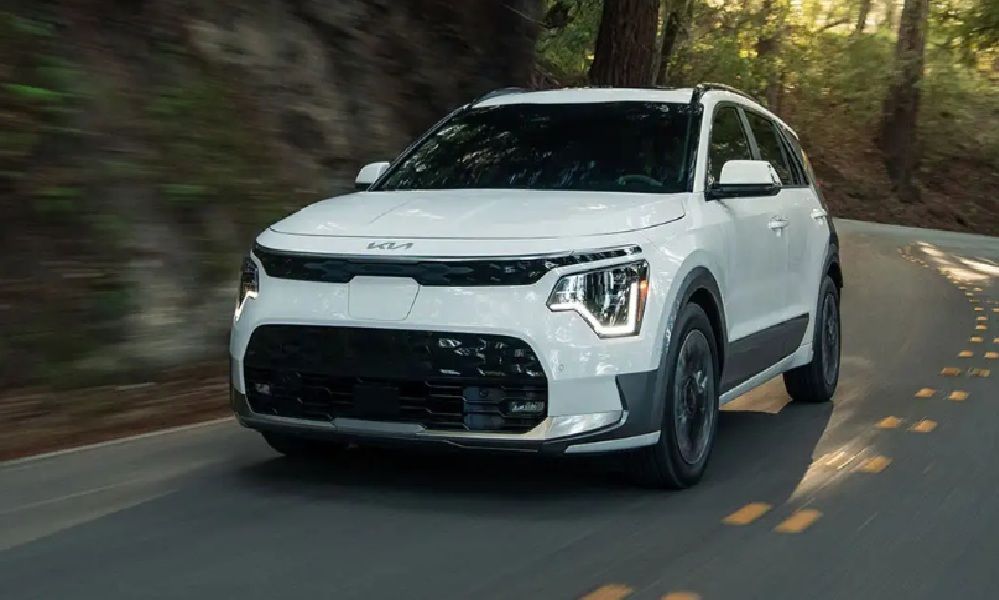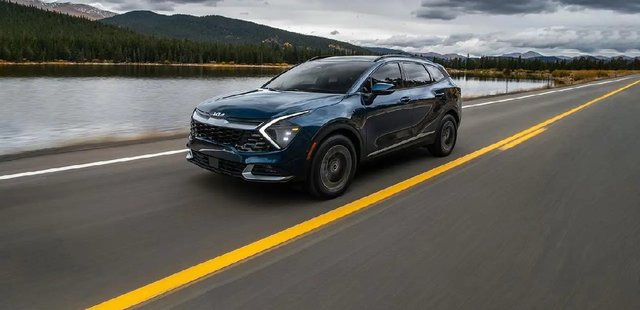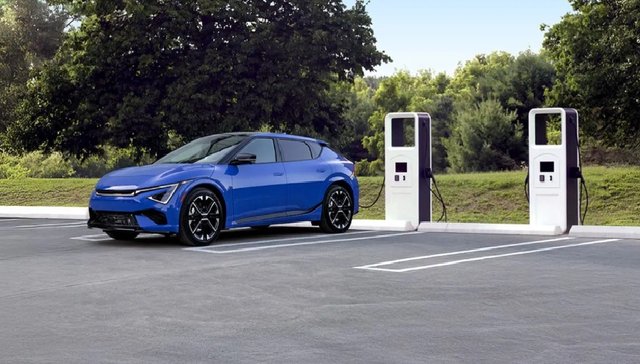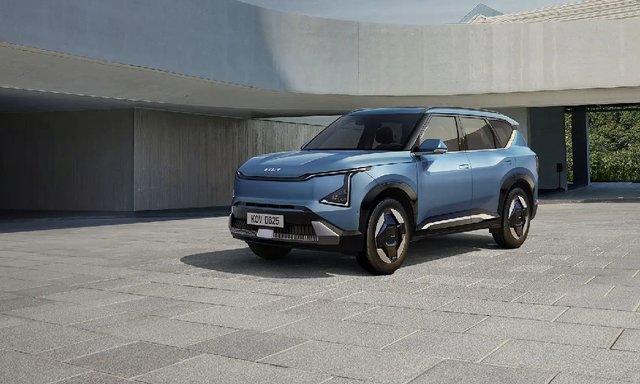See how the powertrains of the 2025 Kia Niro EV, HEV, and PHEV deliver eco-friendly performance with strengths for various driving needs
The automotive landscape continues its rapid evolution toward electrification, and few vehicles exemplify this transition better than the Kia Niro lineup. With three distinct powertrain options – fully electric (EV), hybrid (HEV), and plug-in hybrid (PHEV) – the Niro lineup offers eco-conscious drivers multiple paths to reduced emissions and enhanced efficiency.
Power Sources: How Each Niro Moves
Kia Niro EV: Pure Electric Motivation
The Niro EV represents the fully electric member of the family, powered exclusively by a permanent magnet synchronous motor that produces 201 horsepower (150 kW) and 255 Nm of torque. This powertrain draws energy from a substantial 64.8 kWh lithium-ion battery pack.
Unlike its siblings, the Niro EV operates with zero tailpipe emissions and is completely independent from gas. The electric motor delivers its maximum torque instantly, providing the quickest acceleration in the Niro lineup despite being heavier than its hybrid counterparts.
The Kia Niro EV propulsion system is remarkably simple from a mechanical perspective. With no transmission in the traditional sense, power flows directly to the front wheels through a single-speed reduction gear with a 10.65:1 ratio.
Kia Niro HEV: Harmonious Hybrid
The Kia Niro HEV combines a 1.6-litre direct-injection gas engine with a small electric motor in a parallel hybrid configuration. The combustion engine contributes 105 horsepower, while the electric motor adds just enough assistance to bring the combined system output to 139 horsepower with 195 Nm of torque.
Unlike many hybrids that use continuously variable transmissions (CVTs), the Kia Niro HEV features a conventional six-speed dual-clutch automatic. This transmission provides more familiar shift points and driving dynamics while maintaining excellent efficiency.
The modest 0.7 kWh lithium-ion battery pack is primarily charged through regenerative braking and by capturing excess energy from the gas engine. While not plug-in capable, this self-charging system requires no driver intervention beyond normal fuel stops.
Kia Niro PHEV: The Best of Both Worlds
The Kia Niro PHEV occupies the middle ground, pairing the same 1.6-litre gas engine from the HEV with a more powerful electric motor. Together, they generate a robust 180 horsepower and 195 Nm of torque – significantly more than the standard hybrid.
What truly distinguishes the PHEV is its substantially larger 11.1 kWh lithium-ion battery, which enables meaningful all-electric driving. Like the HEV, the PHEV utilizes a six-speed dual-clutch transmission to deliver power to the front wheels.
The PHEV offers drivers the unique ability to choose between driving modes: all-electric for emissions-free local trips, hybrid mode for maximum efficiency on longer journeys, or a battery-saving mode that preserves electric range for later use.
Performance: Acceleration, Handling, and Driving Dynamics
Kia Niro EV: Responsive and Refined
The Niro EV delivers the most spirited acceleration of the trio. While Kia doesn’t publish official acceleration figures, independent testing suggests the EV can reach 100 km/h in approximately 7.8 seconds – respectable for a vehicle in this segment.
Beyond raw acceleration, the instant torque delivery creates a nimble, responsive driving experience. The battery pack’s location beneath the floor lowers the centre of gravity, improving handling characteristics compared to traditional gas vehicles.
The EV single-speed transmission eliminates gear changes, resulting in a smooth, continuous power delivery that enhances overall refinement. Multiple driving modes and adjustable regenerative braking allow drivers to calibrate the driving experience to their preferences.
Kia Niro HEV: Balanced Efficiency
The Kia Niro HEV prioritizes fuel efficiency over outright performance, with 100 km/h acceleration taking approximately 8.9 seconds. While not quick by modern standards, it’s adequate for everyday driving scenarios.
The dual-clutch transmission provides more engaging driving dynamics than the CVTs found in many competitors. Shifts are generally smooth, though some drivers may notice the transition between electric and gas power during moderate acceleration.
With its lighter weight compared to the EV and PHEV variants, the HEV offers slightly more agile handling, though the difference is subtle during normal driving. The suspension tuning strikes a good balance between comfort and body control.
Kia Niro PHEV: Enhanced Hybrid Performance
The more powerful electric motor and larger battery of the Kia Niro PHEV give it a noticeable performance advantage over the standard hybrid. Acceleration to 100 km/h takes approximately 7.5 seconds, nearly matching the EV despite the additional weight of carrying both propulsion systems.
When operating in all-electric mode, the Kia Niro PHEV delivers the same smooth, linear power delivery as the EV, albeit with less overall power. Once the gas engine engages, the transition is generally seamless, especially during gentle acceleration.
The additional weight is most noticeable during spirited cornering, where it doesn’t feel quite as nimble as the HEV. However, for most drivers in everyday situations, the PHEV offers a compelling blend of performance characteristics from both worlds.
Range and Efficiency: How Far Can Each Niro Go?
Kia Niro EV: Long-Range Electric Mobility
The Kia Niro EV offers an impressive 407 km of all-electric range on a full charge. This positions it as a viable option for urban commuting and longer journeys with strategic charging stops.
In terms of efficiency, the Kia Niro EV consumes approximately 16.2 kWh of electricity per 100 km in combined driving conditions. This translates to 2.1 Le/100 km (litres equivalent per 100 kilometres), making it the most energy-efficient of the three variants.
The EV range can be significantly affected by ambient temperature, driving style, and accessory usage. To help mitigate these effects, the Niro EV is available with a heat pump system that improves efficiency in cold weather by reducing the energy required to warm the cabin.
Kia Niro HEV: Marathon Endurance
The Kia Niro HEV achieves an impressive combined fuel economy rating of 4.4 L/100 km, with slightly better efficiency in city driving (4.4 L/100 km) than on the highway (4.3 L/100 km). This reverse of the typical city/highway relationship is a hallmark of hybrid technology.
With its 42-litre fuel tank, the Kia Niro HEV offers approximately 945 km of total range – the longest of any Niro variant. This makes it an excellent choice for drivers who frequently take long trips or have limited access to charging infrastructure.
The HEV cannot travel on electric power alone for extended distances, though it can operate in EV mode for very short distances at low speeds under ideal conditions.
Kia Niro PHEV: Dual-Range Capability
The defining characteristic of the Kia Niro PHEV is its ability to travel approximately 53 km on electric power alone before transitioning to hybrid operation. This all-electric range covers the daily commuting needs of many drivers, potentially allowing weeks between fuel stops for those with short commutes who charge regularly.
Once the battery is depleted, the PHEV operates as a conventional hybrid, achieving approximately 4.9 L/100 km in combined driving. Its total driving range of up to 820 km (electric plus hybrid operation) provides excellent versatility for varying trip lengths.
The efficiency of the Kia Niro PHEV is maximized when the battery is regularly charged and most driving is done within the all-electric range. The standard hybrid may prove more efficient over time for drivers unable to charge frequently due to its lighter weight.
Charging and Refuelling
Kia Niro EV: Flexible Charging Options
The Kia Niro EV supports multiple charging methods to accommodate various situations. Using a standard household outlet (Level 1, 120V), a full charge takes approximately 57 hours – typically only practical for overnight top-ups of partial depletion.
A Level 2 home charger (240V, 7.2 kW) reduces this time dramatically to approximately 9 hours and 5 minutes for a complete charge, making overnight charging convenient and practical. With an 11 kW charger, this time decreases further to about 6 hours and 5 minutes.
For longer journeys, DC fast charging capability allows the Kia Niro EV to recharge from 10% to 80% in approximately 43 minutes using a 350 kW charger or about 45 minutes with a more common 100 kW charger.
Kia Niro HEV: Refuel with a Twist
The Niro HEV requires no charging infrastructure, relying instead on traditional gas refuelling that takes just a few minutes at any service station. Its excellent fuel economy means these stops are infrequent.
The hybrid system automatically manages the small battery’s charge level through regenerative braking and occasional charging from the gas engine, requiring no driver intervention or lifestyle adjustments.
For drivers without access to home charging or those frequently traveling beyond the range of current charging networks, this traditional approach offers simplicity and convenience while delivering significant efficiency improvements over conventional vehicles.
Kia Niro PHEV: Flexibility and Choice
The PHEV offers the most flexible energy replenishment options of the three variants. Its 11.1 kWh battery can be fully charged in approximately 3 hours using a Level 2 charger or overnight with a standard household outlet.
When charging isn’t available or convenient, the Kia Niro PHEV functions perfectly as a self-charging hybrid, utilizing its gas engine to maintain mobility efficiently. This dual-nature approach eliminates the range anxiety sometimes associated with pure electric vehicles.
For maximum efficiency, PHEV owners should establish a regular charging routine, ideally overnight, when electricity rates may be lower. However, unlike the EV, occasional lapses in charging discipline have minimal impact on the vehicle’s usability.
Practical Considerations: Living with Each Niro Variant
Interior Space and Cargo Capacity
All three Niro variants share the same basic interior dimensions, with minor differences in cargo capacity due to battery placement. The EV offers 63.7 cubic feet of cargo space with rear seats folded, slightly less than the PHEV 64.8 cubic feet and the HEV 65.2 cubic feet.
Each model offers approximately 37 cm of rear legroom, providing comfortable accommodation for adult passengers. The PHEV boasts best-in-class rear legroom among compact plug-in hybrid crossovers.
All versions feature the same dual panoramic displays, an available head-up display, and a suite of infotainment features, ensuring a consistent user experience across the lineup.
Maintenance Requirements
The Niro EV features the simplest maintenance schedule, requiring no oil changes and significantly fewer moving parts to service. Primary maintenance items include cabin air filters, brake fluid, and coolant for the battery system.
The HEV and PHEV require traditional maintenance for their combustion engines, including oil changes and spark plug replacements. However, their regenerative braking systems typically extend brake pad life compared to conventional vehicles.
All Niro variants include comprehensive warranty coverage, including a 10-year/160,000 km powertrain warranty and an 8-year/160,000 km warranty on hybrid and electric components.
Cold Weather Performance
The Niro EV is available with a heat pump system that helps preserve driving range in cold weather by reducing the energy required for cabin heating. Additionally, battery preconditioning can optimize performance when you plug the vehicle in before departure.
The HEV and PHEV benefit from having a gas engine that generates waste heat, making cabin warming more energy-efficient in cold conditions. This feature can be a significant advantage in regions with harsh winters.
All Niro models offer heated seats and a heated steering wheel, which provide efficient targeted warmth regardless of powertrain type.
Matching the Right 2025 Kia Niro to Your Lifestyle
The Kia Niro lineup offers three distinct approaches to efficient mobility, each with advantages suited to different driving patterns and preferences.
The Kia Niro EV represents the most environmentally friendly option, with zero tailpipe emissions and the lowest energy costs per kilometre. It’s ideal for drivers who can charge at home, have a predictable driving routine within its range, and value the smooth, responsive performance of electric propulsion.
The Kia Niro HEV offers the simplest ownership experience, requiring no charging infrastructure, delivering excellent fuel economy and the longest total driving range. It’s perfect for drivers who want immediate efficiency gains without changing their refuelling habits.
The Kia Niro PHEV balances these extremes, offering emission-free daily commuting with the security of hybrid operation for longer trips. This versatility makes it suitable for drivers with varying needs or those testing the waters of electrification before committing to a full EV.
All three variants share the practical crossover design of the Kia Niro, comprehensive safety features, and user-friendly technology, ensuring that whichever powertrain you choose, the core Niro experience remains consistent and compelling. The choice ultimately comes down to matching your driving patterns, access to charging, and personal preferences to the Niro variant that best meets your needs.
Learn More About Kia Niro EV at Kia.ca






